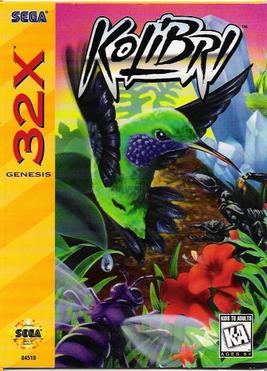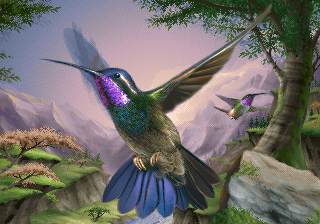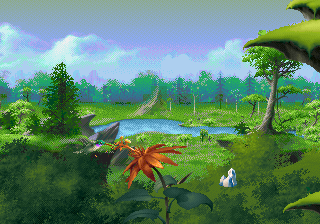GAME CLEAR No. 175 -- Kolibri
video games game clear sega 32x novotradeKolibri (1995, 32X)
Developer: Novotrade International
Publisher: SEGA
Clear Platform: 32X
Clear Date: 6/12/24

| Why should I care? |
|---|
| Kolibri is a highlight on a forgettable platform and a rare forgiving shoot ’em up. |
64 bits. 32 bits. 16 bits. 8 bits. 4 bits. 2 bits. 1 bit! Half-bit! Quarter-bit!
It’s tough to say exactly which of SEGA’s ’90s business missteps was the biggest, but the 32X has a solid argument. The fact that it even came to exist at all is a bit mystifying. The Video Game Historian’s explainer is a great 15-minute rundown, but I’ll do my best to summarize. Basically, SEGA of Japan and SEGA of America experienced different realities with the Genesis/Mega Drive. In North America, the Genesis was a genuine, strong competitor to the Super Nintendo and was still selling well into the early-mid nineties. In Japan, the Mega Drive was a much more modest success, so SEGA of Japan was more anxious to stimulate consumer interest with new hardware. So in January 1994, SEGA of Japan CEO told SEGA of America to develop a new 32-bit, cartridge-based system and have it out by the holiday season that year. They ultimately sold him on making it a Genesis add-on instead and then set to work putting out an entirely new hardware SKU in under a year.
Well, I mean, that’s not so unusual is it? The Mega Drive first debuted in 1988 in Japan and was getting a bit long in the tooth. It’s time for the next-gen console! But that’s the thing — SEGA of Japan was also already making the Saturn! Unbeknownst to SEGA of America! And that’s not all: the fuckin’ thing came out in Japan before the 32X. Really mind-boggling stuff.
And look, I get that the rules of hardware iterations and generations hadn’t really been ironed out in 1994 (and continue to evolve to this day), but this plan strikes me as particularly insane. SEGA’s plan at the time was ostensibly for the 32X to be a budget next-gen option, but at $160, one can understand why many folks decided to just save their pennies for the Saturn (or, perhaps, the PlayStation). If the 32X was to have a shot, it needed to have great games out of the gate, but the tiny development window for the hardware meant an even smaller window for software development. This, combined with late-arriving development kits and a perception of the 32X as a mere stopgap by many 3rd party devs doomed the prospect of a strong launch.
The result was an extremely short-lived console with a modest 40-game library, much of which was critically derided. Many of the good games were just enhanced ports of existing Genesis titles. By my count, just 11 of the 32X’s games were fully original to the console.
Kolibri, a shmup starring an eponymous hummingbid, is one of those games.

You can’t do this on Nintendo
The brainchild of SEGA’s Ed Annunziata, Kolibri feels like a sibling game to his better-known Ecco the Dolphin. It stars an animal protagonist facing an extra-terrestrial threat and features labyrinthine, puzzle-laden levels like its predecessor, with nice, understated music to elevate its moody ambience.
In an interview with SEGA-16, Annunziata said that he was inspired to make Kolibri by a real-life encounter with a hummingbird. He said he was having a smoke one day when a hummingbird flew right up to his face as he was exhaling. Days later, the same hummingbird returned to get in Annunziata’s face to — in his words — “call him out” about the rude encounter. This inspired him to research the family of avian creatures. In so doing, he discovered how “badass” they were and decided he had to make a game about one.
In the same interview, Annunziata correctly called the 32X “dumb,” but in my estimation, he wisely used it to create a beautiful 2D game rather than a choppy, low-fidelity 3D game that so many shot for in those (very) early days of polygons. With its wider range of colors, it was perfectly suited for the lush and floral environments of Kolibri, and it also allowed for the use of another parallax layer, which synergized nicely with the game’s scrolling stages.
The result is a very nice-looking 2D shooting game with fun, varied levels and a one-of-a-kind concept. You know, a good game. The fact that it’s north of bad and is exclusive to 32X I think contributes significantly to its allure, but I want to be clear that it’s straight up good on the merits too.
As was common at the time, it has a merely passable and seldom relevant plot that’s mostly laid out in the manual. Basically, millions of years ago, a planet exploded. A good crystal and an evil crystal were blown into space by the blast. The good one crashed into Earth and its magic allowed it to support life. Now, many more years later, the evil twin has collided with Earth and begun to reverse its life-bearing qualities. With the last of its energy, the good crystal imbues Kolibri with its power and entrusts him to defeat the evil crystal and the Earth life forms it has begun to corrupt with its evil energy.
Sure.
After a quick cutscene in which the above transpires, you must guide Kolibri through 20 levels of small-wildlife-blasting action to find and destroy the evil crystal. Objectives in each stage vary. Some are pretty traditional, forced-scrolling shooting stages in which the only goal is to kill enemies and not get hit. Others are free-roaming stages in which Kolibri must solve environmental puzzles in order to reach the exit and continue. I found these puzzle stages more compelling since they’re a bit different from what most games of the genre offer, but I enjoyed almost everything the game threw at me. I will say that the puzzles generally amounted to finding items necessary to destroy barriers and then using them on said barriers, maybe with some maze navigation involved. A bit repetitive at times perhaps, but the healthy enemy and environment varieties go a long way to mitigate this quibble.
Like the ships of most traditional shmups, Kolibri has a wide variety of weapon types that he can pick up from enemy drops or from the occasional crystal that spawns them endlessly. Some are better at crowd control, while others are great at dealing with single targets like large enemies or bosses. They can be upgraded twice, and I must admit that I was playing on Easy, so the fully-upgraded homing attack options really melted almost everything on screen. But that’s okay! Most shmups of the era were relentlessly difficult, and while I’ve persisted through a small handful of favorites, it was nice to have a game like this with manageable encounters and a real sense of power as a player. It’s a pleasant irony that I got that feeling more as a hummingbird than I usually do as a spaceship.
Contributing to the game’s approachability are its comparatively short levels in the early going and generous checkpointing in later stages. After dying, you respawn at the beginning of the stage or previous checkpoint in whatever state you arrived there in. This means that if you are approaching the end of a stage or area in dire straits, you can instead die on purpose and give that section another go. This mechanic gave me the confidence to know that I couldn’t get “stuck” near the end of the game with low health and a shitty weapon or something like that. It’s a nice system, and it’s another argument for Kolibri as a great starter shmup that I’m growing more and more credulous to as I write this.
If Kolibri’s home on a weird platform, unique concept, and actually-good design and gameplay aren’t enough for you, then maybe you’ll at least be charmed by a look at the manual. Ol’ Ed was apparently serious about his research, as the end of the manual for the game includes instructions on how to build your own feeder, pages of “Amazing Facts about Hummingbirds,” and a substantial list of videos and books anyone else with an interest in the birds might have.
But I say play it. It’s a worthy game.

Welcome to the Machine
But just how are you supposed to play this game? Well, you should emulate it, of course. It’s never been ported anywhere, and the 32X, once a clearance bin failure, is now somehow nearly as expensive as it originally retailed for — possibly more if you want the power and audiovisual cables necessary to actually use it with the Genesis you hopefully already have. A loose cartridge of Kolibri will now set you back over $100. What kind of idiot would pay those prices?
Me, Clayton, that’s who. Unfortunately, I still sort of think playing on original hardware is “an experience” and have a whole room and tube TV dedicated to devices that output analog video. And my path to finally beating a 32X game was an experience indeed.
I’ve kind of just always assumed I would eventually own all unique SEGA home hardware, but I didn’t have the foresight (or disposable income) to buy the 32X or SEGA CD when they were well and truly affordable. COVID seems to have irreversibly fucked up the retro market, though, so when I eventually saw a 32X at a swap meet a couple years ago, I begrudgingly paid its $100+ asking price.
I have a rule about buying games that I generally try to stick to, which is that I have to have a good-faith belief that I will someday play (and ideally finish) it. The game goes for hardware. I wasn’t buying the 32X just for it to live on a shelf and scratch some completionist itch; I had to find something worth playing on it.
As it happened, I already had a couple 32X games in my collection from a cheap lot of Genesis games I’d bought years prior: Virtua Fighter and Metal Head. These were enough to test it, but neither kept my attention long. Not long after, I found Star Wars Arcade at a local shop and ebayed Shadow Squadron. Both offer somewhat novel polygonal space shooting, but the poor underpowered 32X really shouldn’t have been doing all that. Neither of these inspired me to see them through to the end either. I was struggling to find an actually-good game for the ill-fated device.
Conventional wisdom would’ve pushed me toward Knuckles Chaotix, frequently touted as the best of the platform, but I dunno man. I’ve played Sonic. Plus, that game’s gotten expensive like all the rest of them.
Finally, at MAGFest 2023, I saw Kolibri at a dealer’s booth. Seeing a cool, interesting, or rare game like that right before my eyes has a way of tugging at my poor impulse control, so I bought it. Plus, it was a game that might finally allow me to fulfill my goal of finishing a 32X game. Then, disaster struck.
When I got it home, I was crestfallen to discover that my poor 32X wouldn’t boot. No amount of jostling or blowing or alcohol swabbing would convince the thing to play my games. Another setback. I figured it must need a its capacitors replaced or something, which was above my pay grade, but I made a mental note to reach out to an online provider of such services. Because of the activation energy required to do all that, I tabled the task for some time.
Finally, mere days ago, I reached out to Christa Lee’s Sound Retro Co. to inquire about servicing the device. She got back to me saying the 32X seldom fails but that she’d be happy to do some diagnostics and quoted me some prices for possible fixes. Inspired by her stated unlikelihood that the thing was actually cooked, I decided to a little more Googling for common 32X problems. Results came up about finicky ribbons inside the thing that often needed to be “removed and reseated.” I didn’t know if I could handle that, but I decided to open the thing up and take a look.
To my eye, the ribbons looked just fine, but I decided to apply a little pressure on them in the direction of their connections. Apparently that fuckin’ did it, because the next time I put the 32X into my Genesis, it worked like a charm! Hot damn. I’m a regular tinkerer. Oh, and I should probably thank Christa for saving me some money and time. Shoutouts are due, in any case.
Anyway, I finally got Kolibri running and remembered why I bother with all this shit. It’s some kind of magic, man. I don’t think I get off on the nostalgia of CRT glow or whatever, I think it’s the stewardship. Plug in all these 30-year-old computer parts and slam a cartridge in there and somehow it all still works. The miracle of solid-state electronics, sure, but also the hands these things have passed through that cared enough about them not to discard them carelessly.
Even if so, I’m by no means a retro purist. This absolutely isn’t the only way to experience Kolibri or whatever. I play ports and remasters and remakes all the time. They absolutely should be readily available! But as long as I’m fortunate enough to have the space for it and as long as the electron guns don’t give out, I think I’ll keep my little vintage tech shrine. And hell, maybe I’ll finally actually learn to solder and recap and all those things so I can truly keep these things running as long as possible, for someone else’s benefit if not mine.
Or, I don’t know, maybe all this bloviating has shades of defensiveness for a reason. Maybe I’m just a consumerist SEGAhead loser. Who’s to say?
Kolibri is still fun regardless.